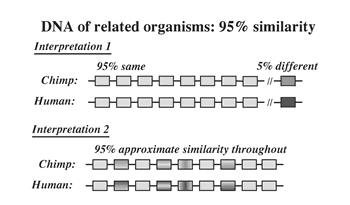|
Exploring the very essence of what makes us
human.
by Charles Pasternak
Who are we?
Are we just another
primate - The Third Chimpanzee according to writers like Jared Diamond(1)
- or is there something special about us that distinguishes man
from every other living creature, as philosophers - even 'Darwinians'
like Dan Dennett(2) - believe? No one doubts that over the last
10,000 years or so, humans alone have been able to change their
life styles out of all recognition: concrete cities and the internet,
heart transplants and space flights. The question is, how? Is the
difference between man and chimpanzee merely quantitative - a heightened
ability to think and reason, for example - or do we also possess
some distinct quality that makes us unique? I favour the former
view, but do not believe that it is simply a matter of cerebral
function (Homo sapiens, 'thinking' or 'wise' man).
Take the second point
first. Chimpanzees and dolphins can be taught to work out quite
complicated problems that undoubtedly require the powers of thought
and reason (Fig 1). Indeed, there is considerable overlap between
the mental agility of a bright gorilla and a backward child. I consider
that it is not a single feature, but a fortuitous combination of
several, that is the key to human behaviour. What might those attributes
be?
The first is the mobile
thumb, that permits humans to grasp objects with the 'precision
grip', in which an article is held between thumb and the fingers,
whereas other primates can only use the 'power grip', in which something
is clasped between clenched fingers alone. The precision grip allowed
early species of Homo to start manufacturing primitive tools and
enables us tie our shoelaces. Without the mobile thumb there would
be no Bayeux Tapestry and no Nigel Kennedy playing Vivaldi.
The second is a more
elaborate vocal cord, that lets humans utter a variety of sounds
denied to an ape. You will not hear the sounds of an Ella Fitzgerald
or a Luciano Pavarotti among the chimpanzees of Gombe. Yet a human
baby has a vocal cord similar to that of an ape, high up within
the larynx. An interesting consequence is that babies - like chimpanzees
- can swallow and breathe at the same time. You and I cannot.
The third is a larger number of cortical neurons (nerve cells in
the top layer of the brain) in man than in ape - three times as
many in a modern human as in a chimpanzee. It is these neurons that
underly the thoughts and feelings of our mind.
None of these attributes
alone accounts for the difference between man and chimp, but in
combination they endow us with the essential features of humanity.
I am reminded of a remark Peter Medawar made in regard to immune
function: `One individual differs from all others not because he
has unique endowments but because he has a unique combination of
endowments'(3). We may also note that each attribute represents
no more than a subtle difference between human and chimp: a slightly
longer thumb and shorter fingers, a developmental change in the
structure of the larynx at around one year of age, a gradually increasing
number of cortical neurons (but a neuron in a chimpanzee is indistinguishable
from that in a human).
If sapiens is not the most appropriate way to define a human being,
what is? I propose that it is quaerens, 'searching' or 'questing'
(and please note that a derivative of quest is conquest, a very
human quality). Of course all animals search - for food and water,
shelter and a mate - but in man the ability to search has become
heightened as a result of the three attributes mentioned above:
our search is triggered not just by need, but by curiosity as well.
To search for the source of the Nile, to ponder the movements of
the planets, has no direct bearing on our well-being. Yet it is
such curiosity that underlies human behaviour. Man has explored
the entire globe, and colonised most of it; the chimpanzee has remained
within its environment. Man never stops tinkering with the way he
lives - he seeks novelty in the houses he inhabits and the cars
he drives, the food he eats and the clothes he wears; the chimpanzee
has not changed its life style over millions of years.

Figure 2 - with thanks to Professor Christopher Leaver
Plants
searching for light
|
You might say that
searching is a particularly inappropriate characteristic with which
to identify human demeanour, since it is shared not only with other
animals, but with every type of plant and microbe. Quest is as fundamental
a feature of living organisms as growth and division. Plants do
not merely use the energy of light, they seek it out as actively
as any sunbather on the Mediterranean (Fig 2). Bacteria don't just
metabolise organic nutrients, they swim towards them (and away from
toxic molecules). Indeed several of the genes involved in searching
by plants and microbes have homology with genes of animals and man,
where they play a role in nerve transmission and other processes.
The common feature is a 270-long stretch of amino acids called the
LOV (light, oxygen and voltage) or PAS domain (4) in the relevant
proteins. It is this domain that 'senses' the stimulus and triggers
the appropriate response, be it growth of plant stems or movement
in bacteria or a nervous impulse in animals.
So is it not then
paradoxical to focus on quest as the essence of humanity, when it
is merely a somewhat enhanced ability to do so that distinguishes
man from chimpanzee and all other creatures? I do not think so.
On the contrary, the closeness between the genetic make-up of man
and ape makes just such a subtle difference the most likely explanation
for our very diverse behaviours. Let us examine this a little more
closely.
The genomes of man
and chimpanzee differ by some 2 - 5% (depending on exactly how one
chooses to measure them (5)). This has led scientists to look for
genes - there could be as many as a thousand - that are distinctly
either 'chimp' or 'human'. I do not believe they will find them.
All they will find are some mutations in genes that are common to
ape and man. In short, I favour the second explanation for the genetic
difference between chimpanzees and humans (Fig 3). What is my reason
for this assertion? Not so much that no distinctly 'human' gene
has yet been identified - we don't yet have the complete genome
of the chimpanzee - but rather that those genes that play a role
in the three key attributes I have mentioned, do not seem to be
unique to humans. Let me give an example.
Some years ago it
was discovered that between 2% and 5% of all children have a severe
speech and language disorder. Their grammatical ability is badly
impaired, they have difficulty in articulating words, and they are
unable to control the muscles around their mouth properly. The condition
is hereditary, and persists throughout life. A gene called FOXP2
has been identified as lying at the heart of the problem. A group
of scientists from Leipzig and Oxford have shown that in chimpanzees
and other apes, the FOXP2 gene is different from that in humans.
But within all healthy humans studied, including individuals of
African, Asian, European, South American, Australian aboriginal
and Papua New Guinean descent, the gene is identical. Moreover it
appears not to have mutated over the entire time span (some 200,000
years) that Homo sapiens has been around. In short, it is the first
molecular marker for the development of speech and language to be
identified. And speech and language are dependent on a combination
of two of the three attributes I have identified as being typically
human: a unique vocal cord and many cortical neurons. One might
therefore suppose that the protein coded by the FOXP2 gene is significantly
different in chimpanzees and humans. Indeed, genes like FOXP2 might
account for much of the 5% disparity between the genomes of chimpanzees
and humans. Far from it. The dissimilarity between the chimpanzee
and human FOXP2 gene is just 0.03%, and the FOXP2

Figure 3
The
genetic make-up of chimpanzees and humans.
|
protein of humans differs from its counterpart
in chimpanzees by a mere 2 amino acids out of a total of 715. Many
proteins that perform essentially identical functions in chimpanzees
and humans are considerably more diverse, and we may conclude that
much of the genetic difference between humans and chimpanzees represents
no more than a build-up of 'silent' mutations (including polymorphisms)
that have accumulated over the seven or so million years since the
common ancestor of chimp and human inhabited the forests of Africa.
The argument, of course, extends throughout evolution: there are
no specifically `ape' as opposed to `monkey' genes, and so on. All
creatures that ever lived are made up of genes that can be traced
back to the first multicellular member of the animal kingdom some
500 million years ago. And even that organism inherited the genes
responsible for its metabolism from an archaebacterium alive two
billion years earlier. Evolution does not produce new genes characteristic
of any one species: it merely modifies existing ones and adds a
few variants.
What, you may now
ask, are the consequences of human quest? Will we destroy ourselves
through some catastrophic failure of our making - of our computers
and our weaponry? The astronomer Martin Rees thinks so (7), but
I disagree. In the long term, over the next billions of years, of
course he is right. We - along with every other form of life - are
doomed to extinction as flares from the dying sun boil every ounce
of water off the face of the earth, though that should not trouble
you, or your grandchildren, for many generations yet to come. In
the short term, however, I am more optimistic. Man's pragmatism,
that prevented nuclear disaster during the Cold War, surely protects
him against calamities triggered by current weaponry or by rogue
computers. And so far as the possibility of extinction by a massive
asteroid or a lethal virus is concerned, man is unquestionably the
species most likely to survive: as a result of his incessant quest
for answers to the most formidable problems. He’s been successfully
exploring the realms of science for two thousand years, and he’s
not going to stop now.
Click
here for Twenty Facts from the Book
(1) Jared Diamond: The Rise and Fall
of The Third Chimpanzee (Vintage, 1991)
(2) Daniel C Dennett: Freedom Evolves (Penguin Books, 2003), p 305
(3) Peter Medawar: The Uniqueness of the Individual (2nd ed, Dover
Publications, 1981), p 134
(4) Barry L Taylor and Igor B Zhulin: PAS Domains: Internal Sensors
of Oxygen, Redox Potential and Light. Microbiology and Molecular
Biology Reviews, 63: 479-506 (1999).
(5) Roy J Britten: Divergence between samples of chimpanzee and
human DNA sequences is 5%, counting indels. Proc Nat Acad Sci USA
99: 13633-13635 (2002)
(6) Wolfgang Enard et al: Molecular evolution of FOXP2, a gene involved
in speech and language. Nature 418: 869-872 (2002)
(7) Martin Rees: Our Final Century: Will the Human Race Survive
the Twenty-First Century? (William Heinemann, 2003) |
